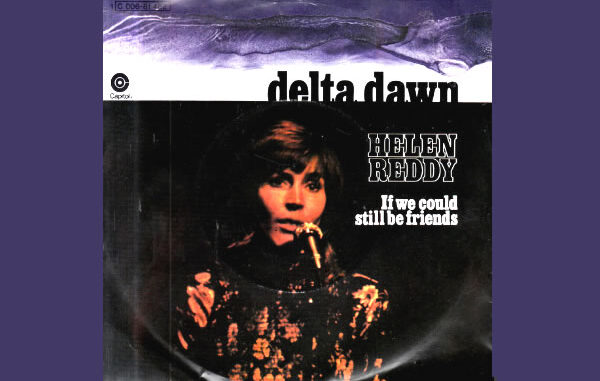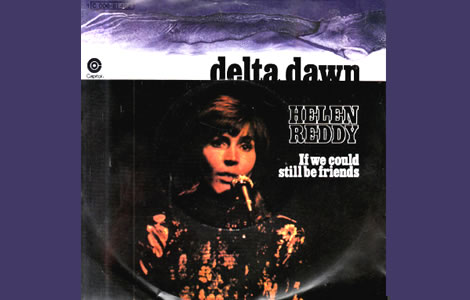
Helen Reddy’s hit Delta Dawn remains one of the most iconic songs of the 1970s, a track that helped solidify her place as one of the premier female voices of her era.

Alongside other influential artists such as Linda Ronstadt, Joni Mitchell, Crystal Gayle, and Barbra Streisand, Reddy was a key player in the Adult-Oriented Rock (AOR) scene, bringing a unique blend of folk, pop, and soft rock to her music.
Delta Dawn was a defining moment in her career, showcasing her vocal power, emotional depth, and ability to connect with listeners on a personal level.
Background on Helen Reddy’s Career
Helen Reddy was born in Melbourne, Australia, in 1941, into a family deeply rooted in show business. From an early age, Reddy pursued a career in entertainment, performing with her family on stage before making her mark in the music industry.
However, it wasn’t until she moved to the United States in the late 1960s that her career truly began to take off.
In 1971, Reddy achieved her breakthrough with I Don’t Know How to Love Him, which quickly became a hit. This success paved the way for more notable tracks, including Delta Dawn in 1973 and her feminist anthem I Am Woman, which went on to become one of her signature songs.
Reddy became one of the most successful female singers of the 1970s, often classified as an AOR artist, standing shoulder to shoulder with other greats of the time like Linda Ronstadt, Joni Mitchell, Crystal Gayle, and Barbra Streisand.
Like her peers, Reddy’s voice was at the forefront of soft rock and pop music, appealing to a wide adult audience while maintaining a distinct identity that leaned toward emotional balladry and storytelling.
The Composition and Recording of Delta Dawn
Delta Dawn was originally written by country singer-songwriter Larry Collins and songwriter Alex Harvey. The song tells the poignant story of a faded Southern belle waiting for a lover who never arrives, holding onto memories of her youth and beauty.
There’s a melancholic sense of nostalgia woven into the lyrics, underscored by Reddy’s commanding yet empathetic delivery. The chorus—”Delta Dawn, what’s that flower you have on?”—became a haunting and memorable hook that resonated deeply with listeners.
The song had initially been recorded by country artist Tanya Tucker, but it was Helen Reddy’s version that propelled it to massive commercial success.
Reddy’s version of Delta Dawn was recorded with producer Tom Catalano, who had worked with her on several other projects. Catalano’s production combined elements of country, pop, and soft rock, helping to make the track more accessible to a broader audience.
Reddy’s voice was front and centre, as the orchestration subtly complemented her powerful vocal performance. The string arrangement added a lush, almost cinematic quality, giving the song a broader appeal beyond its country roots.
Chart Success Worldwide
Released in mid-1973, Delta Dawn became a huge hit, especially in the United States. It reached No. 1 on the Billboard Hot 100 chart in August 1973, marking Reddy’s second No. 1 hit after I Am Woman. The song remained on the chart for several weeks and became one of her signature tracks.
In the UK, however, Delta Dawn didn’t achieve the same level of success as in the U.S., though it did receive airplay and became part of Reddy’s broader influence on the international music scene. In Europe, the song enjoyed modest success, charting in various countries but never quite reaching the top tier of the charts as it had in America.
Asia and Australia were different stories. In her home country of Australia, Reddy was already a beloved figure, and Delta Dawn became another jewel in her crown. While it didn’t top the charts, it was widely played on radio stations and contributed to her popularity throughout the 1970s. In Asia, particularly in Japan and Southeast Asia, where Reddy had a strong fan base, the song was well-received and often included in her concert tours.
What Is Delta Dawn About?
The lyrics of Delta Dawn tell the story of a woman named Delta Dawn, who once had beauty and hope but now clings to the past, dressed in her finery, awaiting a man who promised to return and marry her.
The flower in her hair symbolises her lost youth, and the overall narrative reflects the themes of unfulfilled promises and a life spent waiting for something that may never come. The song’s melancholy tone is rooted in its exploration of lost love, faded dreams, and the passage of time.
Though the song’s narrative is specific to Delta Dawn, its themes resonate with a universal audience. It speaks to anyone who has experienced heartbreak, nostalgia, or the pain of unrealized dreams.
Reddy’s delivery elevates the song beyond its lyrical simplicity, giving it an emotional depth that makes it feel like more than just a country ballad.
Reddy’s Legacy and the Impact of Delta Dawn
Delta Dawn was one of the key tracks that defined Helen Reddy’s career and cemented her as a global star in the 1970s. It followed in the footsteps of her earlier hits, continuing her trend of recording songs with strong narratives and emotional resonance.
Like Linda Ronstadt, Joni Mitchell, Crystal Gayle, and Barbra Streisand, Reddy’s music spoke to a generation of listeners navigating their own emotional lives. She became a voice of strength, vulnerability, and introspection, embodying the complex emotional landscapes of women during that era.
Though her success tapered off in the 1980s, Reddy remains a beloved figure in the history of popular music, with Delta Dawn as one of her lasting contributions to the soundtrack of the 1970s.
The song continues to be a classic, revisited by listeners for its timeless exploration of heartbreak and memory, and a reminder of Helen Reddy’s profound impact on the music world.
